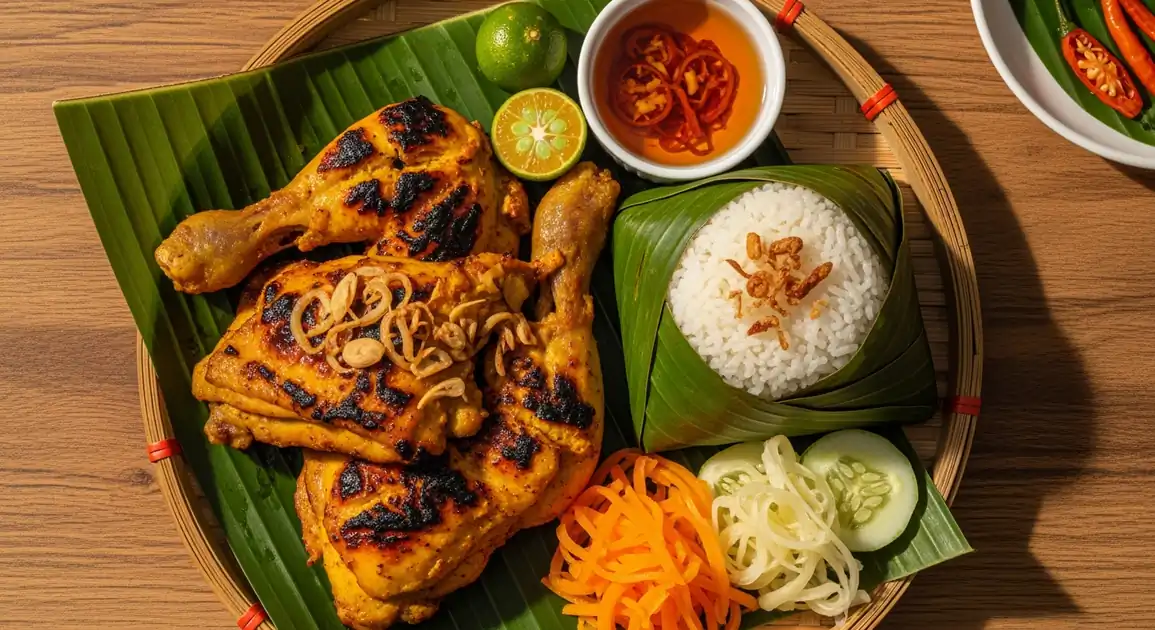Chicken Inasal
Inasal na Manok

Description
In Manila, Chicken Inasal has become a beloved staple across the bustling metropolis, with countless establishments ranging from street vendors to upscale restaurants serving this grilled delight. While originating from Western Visayas, Manila's adoption of inasal demonstrates how this dish has transcended regional boundaries to become a national favorite, appreciated by the capital's diverse population.
Dietary Information
Serving information
Serving style
In Manila, inasal is typically served on plates with rice (sometimes wrapped in banana leaf), small dishes of sinamak vinegar, soy sauce with calamansi, and occasionally atchara. Many establishments provide plastic gloves or wet wipes for eating with hands, though utensils are always available.
Quick facts
Most inasal establishments operate from 10 AM - 10 PM, with mall locations following mall hours (10 AM - 9 PM). Some popular chains and street vendors in entertainment districts extend until midnight or later.
Safety Tips
What to Look For
-
Chicken being actively grilled, not sitting pre-cooked
Freshly grilled chicken minimizes bacterial growth and ensures proper cooking temperatures.
-
Clean grilling station with proper food handling
Observe if the vendor uses separate utensils for raw and cooked chicken and maintains a clean workspace.
-
Chicken cooked until juices run clear with no pink near bones
Properly cooked chicken reaches internal temperatures that kill harmful bacteria. The meat should not appear pink, especially near bones.
-
High customer turnover indicating freshness of ingredients
Popular stalls sell more chicken daily, meaning ingredients aren't sitting around for extended periods.
-
Staff wearing gloves when handling cooked food
This reduces chances of cross-contamination, though many authentic places may use clean bare hands as is traditional.
What to avoid
-
Pre-grilled chicken sitting at room temperature for long periods
Bacteria multiply rapidly on cooked meat at room temperature. Choose vendors who grill upon order or have proper warming setups.
-
Undercooked chicken with blood near bones
Undercooked chicken may contain harmful bacteria like Salmonella. Ensure meat is fully cooked through with no redness near bones.
-
Raw chicken stored next to or above cooked chicken
Cross-contamination can occur when raw chicken juices drip onto cooked items.
-
Dirty grilling area with visible flies or pests
Indicates poor hygiene practices that can contaminate food.
-
Reused marinade from raw chicken as sauce
Marinade used for raw chicken must be thoroughly cooked if served as sauce. Avoid places that appear to reuse raw marinade.
Price information
Price range
Budget tips
- Street food inasal along university belts (UST, UP Diliman) offers best value at 90-180 PHP per serving.
- Food courts in malls like SM, Robinsons have competitive pricing (150-220 PHP) with air-conditioned comfort.
- Order 'pecho-pak' combos for more variety at better value in established restaurants.
- Look for weekday lunch promos in business districts like Makati and BGC.
Value indicators
- Portion size relative to price point.
- Quality of chicken (native chicken commands premium prices).
- Inclusion of traditional sides (rice, soup, atchara).
- Free sauce refills and unlimited rice options.
- Chicken oil availability without additional charge.
Where to Find This Dish
Makati
Mix of high-end restaurants and affordable options catering to office workers.
Glorietta, Greenbelt, Poblacion
Lunch, After-office hours
Quezon City
Diverse range of inasal establishments from street food to casual dining restaurants.
Timog Avenue, Maginhawa Street, UP Town Center
Lunch, Dinner, Late night
Manila City
Traditional eateries and food stalls offering authentic flavors at budget-friendly prices.
Binondo, Quiapo, University Belt
Lunch, Early dinner
Vendor Tips
- Ask for extra 'chicken oil' (annatto oil) for your rice – most places provide this complimentary.
- In mall food courts, lines are shortest before 11:30 AM or after 1:30 PM.
- Manila inasal spots often have loyalty cards or app-based discounts worth asking about.
How to Order
Regional Variations
-
Upscale Manila Inasal
(Premium Inasal)
High-end restaurants in BGC and Makati offer gourmet versions using organic, free-range chicken with premium marinades and presentation.
-
Fast Food Inasal
(Quick-Serve Inasal)
Chain restaurant adaptations emphasize convenience and consistency, sometimes with sweeter marinades catering to Manila palates.
-
Fusion Inasal
(Contemporary Inasal)
Modern restaurants in areas like Poblacion and Maginhawa experiment with non-traditional marinades and international flavor influences.
-
Mall Food Court Inasal
(Food Court Inasal)
Standardized versions focused on quick service and value meals, often with combo promotions.
Cultural context
History
Chicken Inasal originated in the Western Visayas region of the Philippines, with both Bacolod City and Iloilo claiming roots to this beloved dish. The term 'inasal' comes from the Hiligaynon word meaning 'chargrilled' or 'roasted meat.' What began as humble street food in the 1970s has evolved into a national Filipino favorite, with legendary establishments like the original vendors at Bacolod's Manokan Country helping to popularize it nationwide. The dish represents the Filipino talent for creating vibrant flavors from simple, accessible ingredients.
Local significance
In Manila's melting pot culture, Chicken Inasal represents the successful migration of provincial cuisine to the capital, adapted to urban tastes while maintaining its essential character. It's both everyday food and comfort food for Manila residents.
Eating customs
- Eating with hands is acceptable but less common than in provinces; most diners use utensils.
- Many Manila establishments serve inasal with multiple dipping sauces beyond traditional vinegar.
- Rice often comes first, with chicken served when ready, different from simultaneous serving in provinces.